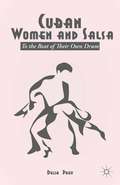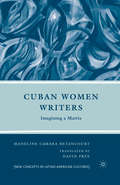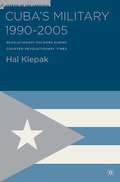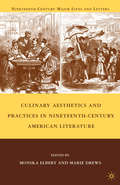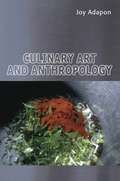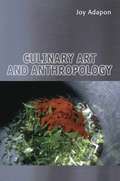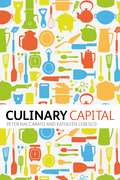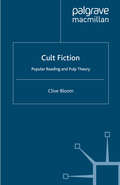- Table View
- List View
Cuban Women and Salsa: To the Beat of Their Own Drum
by D. PoeySalsa is both an American and transnational phenomenon, however women in salsa have been neglected. To explore how female singers negotiate issues of gender, race, and nation through their performances, Poey engages with the ways they problematize the idea of the nation and facilitate their musical performances' movement across multiple borders.
Cuban Women Writers: Imagining a Matria (New Directions in Latino American Cultures)
by M. BetancourtBetancourt examines women's writings in relation to language, power, sexuality and race in contemporary Cuba, analyzing the creation of alternative matria frameworks that enunciate a feminist/feminine perspective of the nationalist discourse.
The Cubans: Ordinary Lives in Extraordinary Times
by Anthony DePalmaThe Cubans is a revelatory account of life in one of the most restrictive, isolated and misunderstood places in the world.In this pioneering work of life-writing and reportage, Anthony DePalma reconstructs the interwoven stories of five ordinary citizens and their families to bring the true story of the Cuban people the world.Through their extraordinary journeys, from Castro’s heyday, through the devastation of post-Soviet collapse, to the false dawn of recent years, we witness the drama and hardships of life across six decades of socialist state control – where even today the government decides what work you can do and where you live; where food is rationed, basic medicines are unavailable, buildings collapse and rubbish goes uncollected; where millions break the law every day simply to get by. Many celebrate Cuba, one of the world’s five remaining communist countries, for bravely holding out against the rampant capitalism of the West. The Cubans lays bare the more complex reality, showing how the revolution that once inspired its people has since tested their faith with tragedy and disillusionment, and revealing the daily acts of heroism and the endlessly adaptive resilience that are required of them to survive.
Cuba’s Military 1990–2005: Revolutionary Soldiers During Counter-Revolutionary Times (Studies of the Americas)
by H. KlepakThis book is the first examination of the Cuban military in the context of Cuba's political and economic challenges in the aftermath of the collapse of the USSR - and therefore of Soviet economic, political and psychological support. It provides important historical and political contexts of the development and engagement of the military.
Cubism and Abstract Art (Routledge Revivals)
by Alfred H. Barr, Jr.Originally published in 1936, in this classic account of the development of abstract art Alfred Barr analyses the many diverse abstract movements which emerged with bewildering rapidity in the early years of the twentieth century, and which had an impact on every major form of art. Barr traces the history of nonrepresentational art from its antecedents in late nineteenth-century painting in France – Seurat and Neo-Impressionism, Gauguin and Synthetism, and Cézanne – through abstract tendencies in Dada and Surrealism. He distinguishes two main trends in abstract art: the geometrical, structural current as it developed in Cubism and later in Constructivism and Mondrian, and the intuitional, decorative current running from Matisse and Fauvism through Kandinskt and, later, Surrealism. He shows how individual movements influenced one another, and how many artists experimented with more than one style. Barr also discusses the involvement of a number of abstract movements in architecture and the practical arts – the Bauhaus in Germany, de Stijl in Holland, Purism in France, and Suprematism and Constructivism in Russia.
Cubism and Abstract Art (Routledge Revivals)
by Alfred H. Barr, Jr.Originally published in 1936, in this classic account of the development of abstract art Alfred Barr analyses the many diverse abstract movements which emerged with bewildering rapidity in the early years of the twentieth century, and which had an impact on every major form of art. Barr traces the history of nonrepresentational art from its antecedents in late nineteenth-century painting in France – Seurat and Neo-Impressionism, Gauguin and Synthetism, and Cézanne – through abstract tendencies in Dada and Surrealism. He distinguishes two main trends in abstract art: the geometrical, structural current as it developed in Cubism and later in Constructivism and Mondrian, and the intuitional, decorative current running from Matisse and Fauvism through Kandinskt and, later, Surrealism. He shows how individual movements influenced one another, and how many artists experimented with more than one style. Barr also discusses the involvement of a number of abstract movements in architecture and the practical arts – the Bauhaus in Germany, de Stijl in Holland, Purism in France, and Suprematism and Constructivism in Russia.
Cuckoo Land: The Cuckooing Risk Environment (Drugs, Crime and Society)
by Jack SpicerDrawing on rich qualitative data, this book presents a novel way of understanding the drug market-related harm of ‘cuckooing’, providing a theoretically informed account of this increasingly high-profile area.Applying the framework of the ‘risk environment’, the book examines why people become cuckooed, how it is responded to and how this exploitative practice is socially produced. In doing so, a diverse range of environments and features relevant to cuckooing are analysed, including the role of housing, political economy, drug policy, policing and social exclusion. By interrogating how these constrain and enable the actions of people who are affected, the book develops a critical analysis that recognises the complexity of cuckooing while eschewing superficial explanations of why it occurs. Resisting simplistic solutions, it also considers what an enabling environment capable of reducing the harms of this exploitative practice might look like.Cuckoo Land will be of interest to academic researchers in the fields of criminology, victimology, social work and drugs. It will also be essential reading for policymakers and practitioners working on the issue of cuckooing.
Cuckoo Land: The Cuckooing Risk Environment (Drugs, Crime and Society)
by Jack SpicerDrawing on rich qualitative data, this book presents a novel way of understanding the drug market-related harm of ‘cuckooing’, providing a theoretically informed account of this increasingly high-profile area.Applying the framework of the ‘risk environment’, the book examines why people become cuckooed, how it is responded to and how this exploitative practice is socially produced. In doing so, a diverse range of environments and features relevant to cuckooing are analysed, including the role of housing, political economy, drug policy, policing and social exclusion. By interrogating how these constrain and enable the actions of people who are affected, the book develops a critical analysis that recognises the complexity of cuckooing while eschewing superficial explanations of why it occurs. Resisting simplistic solutions, it also considers what an enabling environment capable of reducing the harms of this exploitative practice might look like.Cuckoo Land will be of interest to academic researchers in the fields of criminology, victimology, social work and drugs. It will also be essential reading for policymakers and practitioners working on the issue of cuckooing.
Culinary Aesthetics and Practices in Nineteenth-Century American Literature (Nineteenth-Century Major Lives and Letters)
by M. Drews M. ElbertCulinary Aesthetics and Practices in Nineteenth-Century American Literature examines the preponderance of food imagery in nineteenth-century literary texts. Contributors to this volume analyze the social, political, and cultural implications of scenes involving food and dining and illustrate how "aesthetic" notions of culinary preparation are often undercut by the actual practices of cooking and eating. As contributors interrogate the values and meanings behind culinary discourses, they complicate commonplace notions about American identity and question the power structure behind food production and consumption.
Culinary Art and Anthropology
by Joy AdaponCulinary Art and Anthropology is an anthropological study of food. It focuses on taste and flavour using an original interpretation of Alfred Gell's theory of the 'art nexus'. Grounded in ethnography, it explores the notion of cooking as an embodied skill and artistic practice. The integral role and concept of 'flavour' in everyday life is examined among cottage industry barbacoa makers in Milpa Alta, an outer district of Mexico City. Women's work and local festive occasions are examined against a background of material on professional chefs who reproduce 'traditional' Mexican cooking in restaurant settings.Including recipes to allow readers to practise the art of Mexican cooking, Culinary Art and Anthropology offers a sensual, theoretically sophisticated model for understanding food anthropologically. It will appeal to social scientists, food lovers, and those interested in the growing fields of food studies and the anthropology of the senses.
Culinary Art and Anthropology
by Joy AdaponCulinary Art and Anthropology is an anthropological study of food. It focuses on taste and flavour using an original interpretation of Alfred Gell's theory of the 'art nexus'. Grounded in ethnography, it explores the notion of cooking as an embodied skill and artistic practice. The integral role and concept of 'flavour' in everyday life is examined among cottage industry barbacoa makers in Milpa Alta, an outer district of Mexico City. Women's work and local festive occasions are examined against a background of material on professional chefs who reproduce 'traditional' Mexican cooking in restaurant settings.Including recipes to allow readers to practise the art of Mexican cooking, Culinary Art and Anthropology offers a sensual, theoretically sophisticated model for understanding food anthropologically. It will appeal to social scientists, food lovers, and those interested in the growing fields of food studies and the anthropology of the senses.
Culinary Capital
by Peter Naccarato Kathleen LebescoTV cookery shows hosted by celebrity chefs. Meal prep kitchens. Online grocers and restaurant review sites. Competitive eating contests, carnivals and fairs, and junk food websites and blogs. What do all of them have in common? According to authors Kathleen LeBesco and Peter Naccarato, they each serve as productive sites for understanding the role of culinary capital in shaping individual and group identities in contemporary culture.Beyond providing sustenance, food and food practices play an important social role, offering status to individuals who conform to their culture's culinary norms and expectations while also providing a means of resisting them. Culinary Capital analyzes this phenomenon in action across the landscape of contemporary culture. The authors examine how each of the sites listed above promises viewers and consumers status through the acquisition of culinary capital and, as they do so, intersect with a range of cultural values and ideologies, particularly those of gender and economic class.
Culinary Man and the Kitchen Brigade: Normative Subjectivity in Western Fine Dining Traditions (Routledge Food Studies)
by Jordan FallonCulinary Man and the Kitchen Brigade offers an exploration of the field of normative subjectivity circulated within western fine dining traditions, presenting a theoretical analysis of the governing relationship between the chef, who embodies the Culinary Man, and the fine dining brigade.The book offers a unique treatment of western haute cuisine’s interlocking regime of labor and aesthetics and theorizes the underexplored kitchen brigade as a model of disciplinary formation. It deploys a heterogeneous set of disciplinary discourses and practices which have the effect of consolidating monopolies on epistemic authority and governance. Each position within the brigade’s hierarchy is subject to distinct, though related, disciplinary practices. Thus, chapters identify the specific practices pertinent to each brigade subject, while also illuminating how they fit together as a coherent hegemonic project. The application of Wynterian and Foucauldian insight to the fine dining brigade offers a political theory of culinary work which departs from other food studies texts. Notably, this work offers an in-depth treatment of the brigade’s colonial dimensions which resonate with emerging critiques, scholarly and general, of the race and gender politics of restaurant labor. The concluding chapters seek to identify where extant modes of resistance or alternative forms of culinary organization may hold the potential to move beyond the hegemonic overrepresentation of Culinary Man.This book will be of great interest to students and scholars from across the social sciences and humanities interested in critical food studies, political and cultural theory, and popular culinary culture.
Culinary Man and the Kitchen Brigade: Normative Subjectivity in Western Fine Dining Traditions (Routledge Food Studies)
by Jordan FallonCulinary Man and the Kitchen Brigade offers an exploration of the field of normative subjectivity circulated within western fine dining traditions, presenting a theoretical analysis of the governing relationship between the chef, who embodies the Culinary Man, and the fine dining brigade.The book offers a unique treatment of western haute cuisine’s interlocking regime of labor and aesthetics and theorizes the underexplored kitchen brigade as a model of disciplinary formation. It deploys a heterogeneous set of disciplinary discourses and practices which have the effect of consolidating monopolies on epistemic authority and governance. Each position within the brigade’s hierarchy is subject to distinct, though related, disciplinary practices. Thus, chapters identify the specific practices pertinent to each brigade subject, while also illuminating how they fit together as a coherent hegemonic project. The application of Wynterian and Foucauldian insight to the fine dining brigade offers a political theory of culinary work which departs from other food studies texts. Notably, this work offers an in-depth treatment of the brigade’s colonial dimensions which resonate with emerging critiques, scholarly and general, of the race and gender politics of restaurant labor. The concluding chapters seek to identify where extant modes of resistance or alternative forms of culinary organization may hold the potential to move beyond the hegemonic overrepresentation of Culinary Man.This book will be of great interest to students and scholars from across the social sciences and humanities interested in critical food studies, political and cultural theory, and popular culinary culture.
Culinary Nationalism in Asia
by Michelle T. KingThis collection of essays proposes a critical, comparative framework for the study of modern foodways, both inside and outside of Asia, through the crucial lens of culinary nationalism. With culinary nationalism defined as a process in flux, opposed to the limited concept of national cuisine, the contributors of this book call for explicit critical comparisons of cases of culinary nationalism within regions, with the intention of recognizing regional patterns of modern culinary development. As a result, the formation of modern cuisine is revealed to be a process that takes place around the world, in different forms and periods, and not exclusive to current Eurocentric models. The book, which includes a foreword from Krishnendu Ray and a preface from James Watson, sets out a fresh agenda for thinking about future food studies scholarship. Key themes considered include: gender; cooking and consumption; the cultivation of taste and authority; the reinterpretation of culinary traditions; inter/national cuisines; hunger, violence, nation; and Asia as culinary imaginary.
Culinary Nationalism in Asia
by Michelle T. KingThis collection of essays proposes a critical, comparative framework for the study of modern foodways, both inside and outside of Asia, through the crucial lens of culinary nationalism. With culinary nationalism defined as a process in flux, opposed to the limited concept of national cuisine, the contributors of this book call for explicit critical comparisons of cases of culinary nationalism within regions, with the intention of recognizing regional patterns of modern culinary development. As a result, the formation of modern cuisine is revealed to be a process that takes place around the world, in different forms and periods, and not exclusive to current Eurocentric models. The book, which includes a foreword from Krishnendu Ray and a preface from James Watson, sets out a fresh agenda for thinking about future food studies scholarship. Key themes considered include: gender; cooking and consumption; the cultivation of taste and authority; the reinterpretation of culinary traditions; inter/national cuisines; hunger, violence, nation; and Asia as culinary imaginary.
Culinary Turn: Aesthetic Practice of Cookery (Ästhetische Praxis #1)
by Anneli KäsmayrKitchen, cooking, nutrition, and eating have become omnipresent cultural topics. They stand at the center of design, gastronomy, nutrition science, and agriculture. Artists have appropriated cooking as an aesthetic practice - in turn, cooks are adapting the staging practices that go with an artistic self-image. This development is accompanied by crisis of eating behaviour and a philosophy of cooking as a speculative cultural technique. This volume investigates the dimensions of a new culinary turn, combining for the very first time contributions from the theory and practice of cooking.
Culling the Masses: The Democratic Origins Of Racist Immigration Policy In The Americas
by David Scott FitzGeraldCulling the Masses questions the view that democracy and racism cannot coexist. Based on records from 22 countries 1790-2010, it offers a history of the rise and fall of racial selection in the Western Hemisphere, showing that democracies were first to select immigrants by race, and undemocratic states first to outlaw discrimination.
Culling the Masses: The Democratic Origins Of Racist Immigration Policy In The Americas
by David Scott FitzGeraldCulling the Masses questions the view that democracy and racism cannot coexist. Based on records from 22 countries 1790-2010, it offers a history of the rise and fall of racial selection in the Western Hemisphere, showing that democracies were first to select immigrants by race, and undemocratic states first to outlaw discrimination.
The Cult and Science of Public Health: A Sociological Investigation
by Kevin DewIn contemporary manifestations of public health rituals and events, people are being increasingly united around what they hold in common—their material being and humanity. As a cult of humanity, public health provides a moral force in society that replaces ‘traditional’ religions in times of great diversity or heterogeneity of peoples, activities and desires. This is in contrast to public health’s foundation in science, particularly the science of epidemiology. The rigid rules of ‘scientific evidence’ used to determine the cause of illness and disease can work against the most vulnerable in society by putting sectors of the population, such as underrepresented workers, at a disadvantage. This study focuses on this tension between traditional science and the changing vision articulated within public health (and across many disciplines) that calls for a collective response to uncontrolled capitalism and unremitting globalization, and to the way in which health inequalities and their association with social inequalities provides a political rhetoric that calls for a new redistributive social programme. Drawing on decades of research, the author argues that public health is both a cult and a science of contemporary society.
Cult british TV comedy: From Reeves and Mortimer to Psychoville (PDF)
by Leon HuntThis book is the first sustained critical analysis of Cult British TV comedy from 1990 to the present day. The book examines ‘post-alternative’ comedy as both ‘cult’ and ‘quality’ TV, aimed mostly at niche audiences and often possessing a subcultural aura (comedy was famously declared ‘the new ‘rock’n’roll’ in the early ‘90s). It includes case studies of Vic Reeves and Bob Mortimer and the sitcom writer Graham Linehan. It examines developments in sketch shows and the emergence of ‘dark’ and ‘cringe’ comedy, and considers the politics of ‘offence’ during a period in which Brass Eye, ‘Sachsgate’ and Frankie Boyle provoked different kinds of media outrage. Programmes discussed include Vic Reeves Big Night Out, Peep Show, Father Ted, The Mighty Boosh, The Fast Show and Psychoville. Cult British TV Comedy will be of interest to both students and fans of modern TV comedy.
Cult british TV comedy: From Reeves and Mortimer to Psychoville
by Leon HuntThis book is the first sustained critical analysis of Cult British TV comedy from 1990 to the present day. The book examines ‘post-alternative’ comedy as both ‘cult’ and ‘quality’ TV, aimed mostly at niche audiences and often possessing a subcultural aura (comedy was famously declared ‘the new ‘rock’n’roll’ in the early ‘90s). It includes case studies of Vic Reeves and Bob Mortimer and the sitcom writer Graham Linehan. It examines developments in sketch shows and the emergence of ‘dark’ and ‘cringe’ comedy, and considers the politics of ‘offence’ during a period in which Brass Eye, ‘Sachsgate’ and Frankie Boyle provoked different kinds of media outrage. Programmes discussed include Vic Reeves Big Night Out, Peep Show, Father Ted, The Mighty Boosh, The Fast Show and Psychoville. Cult British TV Comedy will be of interest to both students and fans of modern TV comedy.
Cult Collectors
by Lincoln GeraghtyCult Collectors examines cultures of consumption and the fans who collect cult film and TV merchandise. Author Lincoln Geraghty argues that there has been a change in the fan convention space, where collectible merchandise and toys, rather than just the fictional text, have become objects for trade, nostalgia, and a focal point for fans’ personal narratives. New technologies also add to this changing identity of cult fandom whereby popular websites such as eBay and ThinkGeek become cyber sites of memory and profit for cult fan communities. The book opens with an analysis of the problematic representations of fans and fandom in film and television. Stereotypes of the fan and collector as portrayed in series such as The Big Bang Theory and films like The 40 Year Old Virgin are discussed alongside changes in consumption practices and the mainstreaming of cult media. Following this, theoretical chapters consider issues of gender, representation, nostalgia and the influence of social media. Finally, extended case study chapters examine in detail the connections between the fan community and the commodities bought and sold. Topics discussed include: The San Diego Comic-Con and the cult geographies of the fan convention Hollywood memorabilia and collecting cinema history The Star Wars franchise, merchandising and the adult collector Online stores and the commercialisation of cult fandom Mattel, Hasbro and nostalgia for animated eighties children’s television
Cult Collectors
by Lincoln GeraghtyCult Collectors examines cultures of consumption and the fans who collect cult film and TV merchandise. Author Lincoln Geraghty argues that there has been a change in the fan convention space, where collectible merchandise and toys, rather than just the fictional text, have become objects for trade, nostalgia, and a focal point for fans’ personal narratives. New technologies also add to this changing identity of cult fandom whereby popular websites such as eBay and ThinkGeek become cyber sites of memory and profit for cult fan communities. The book opens with an analysis of the problematic representations of fans and fandom in film and television. Stereotypes of the fan and collector as portrayed in series such as The Big Bang Theory and films like The 40 Year Old Virgin are discussed alongside changes in consumption practices and the mainstreaming of cult media. Following this, theoretical chapters consider issues of gender, representation, nostalgia and the influence of social media. Finally, extended case study chapters examine in detail the connections between the fan community and the commodities bought and sold. Topics discussed include: The San Diego Comic-Con and the cult geographies of the fan convention Hollywood memorabilia and collecting cinema history The Star Wars franchise, merchandising and the adult collector Online stores and the commercialisation of cult fandom Mattel, Hasbro and nostalgia for animated eighties children’s television
Cult Fiction: Popular Reading and Pulp Theory
by C. BloomHere is an exploration of pulp literature and pulp mentalities: an investigation into the nature and theory of the contemporary mind in art and in life. Here too, the violent, the sensational and the erotic signify different facets of the modern experience played out in the gaudy pages of kitsch literature. Clive Bloom offers the reader a chance to investigate the underworld of literary production and from it find a new set of co-ordinates for questions regarding publishing and reading practices in America and Britain, ideas of genre, problems related to commercial production, concerns regarding high and low culture, the canon and censorship, as well as a discussion of the rhetoric of current critical debate. Concentrating on remembered authors as well as many long disregarded or forgotten, Cult Fiction provides a theory of kitsch art that radically alters our perceptions of literature and literary values whilst providing a panorama of an almost forgotten history: the history of pulp.
